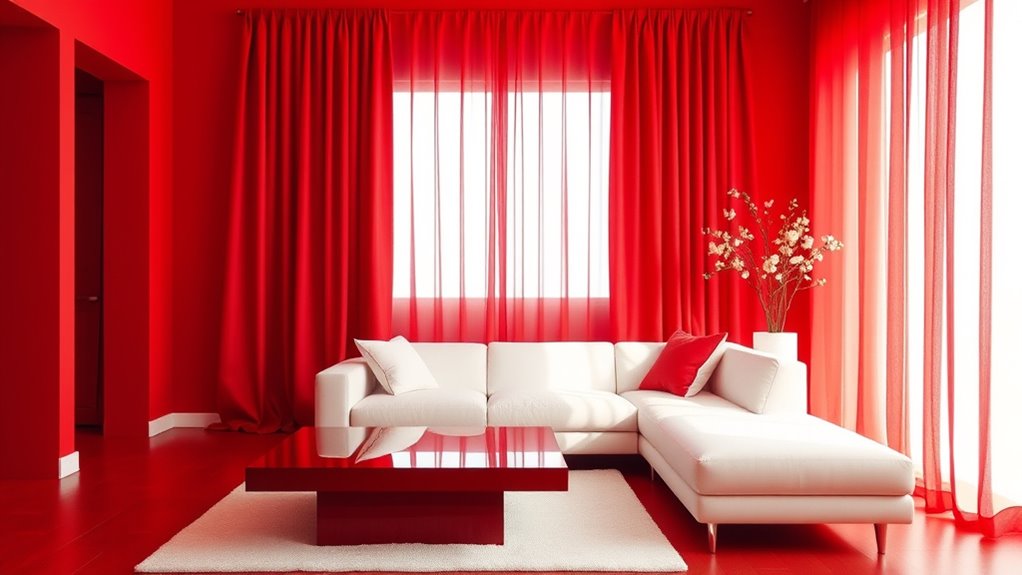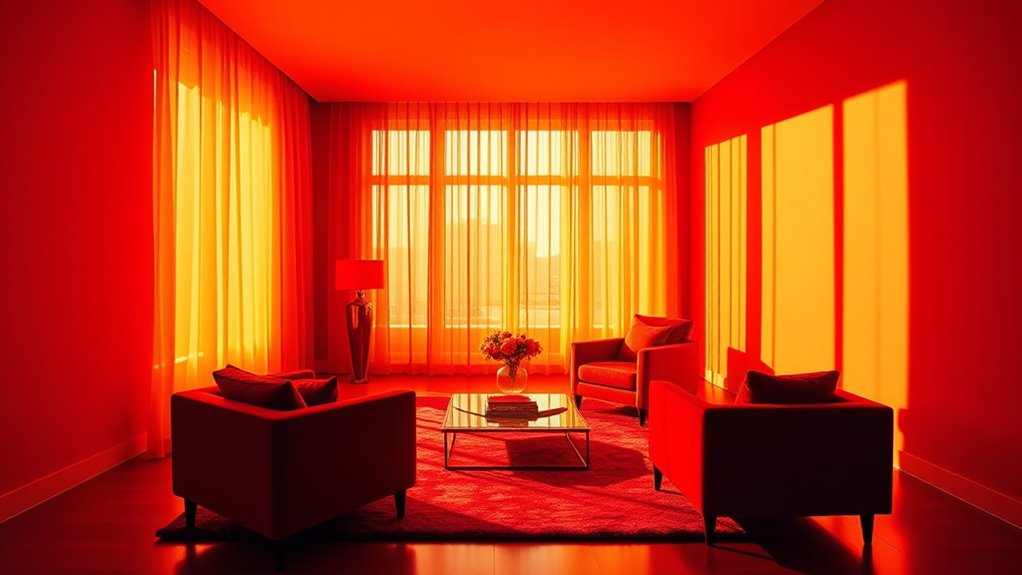To create vibrant, monochrome rooms, focus on lighting, textures, and accessories to add depth and interest. Use warm or cool lighting to mood-enhance, and incorporate varied materials like matte walls or glossy decor for contrast. Add artwork and accents in slightly different shades or textures to break monotony while maintaining cohesion. By balancing these elements, you’ll craft a space that’s dynamic, immersive, and full of subtle surprises—discover more ways to elevate your monochrome palette as you explore further.
Key Takeaways
- Use varied lighting effects to enhance hue richness and create dynamic mood shifts within the monochrome palette.
- Incorporate textures, finishes, and reflective surfaces to add depth and visual interest to the space.
- Select accessories, artwork, and decor in slightly different shades or textures to break monotony and introduce focal points.
- Apply color psychology principles to choose hues that evoke desired emotions, maintaining harmony and vibrancy.
- Balance tactile elements and strategic lighting to emphasize depth, richness, and vibrancy in a cohesive monochrome environment.

Have you ever wondered how a splash of bold color can transform a room from ordinary to extraordinary? When working with monochrome palettes, the key lies in understanding how lighting effects and color psychology can elevate your space. Monochrome rooms, often seen as minimalist or subdued, can become vibrant and dynamic when you harness the power of lighting. Bright, warm lighting enhances the richness of a single hue, making reds feel more passionate or yellows more cheerful. Conversely, cooler lighting can add a calming effect, emphasizing serenity and sophistication. Experimenting with different lighting effects allows you to create various moods within the same monochrome color, giving your room versatility and depth. Additionally, incorporating texture and material can significantly influence how the color appears and feels within your environment.
Lighting and color psychology transform monochrome spaces into vibrant, sophisticated environments with depth and mood.
Color psychology plays a essential role in shaping your environment when you choose a monochrome palette. If you opt for deep blues, your room can evoke tranquility and focus, perfect for a home office or retreat. Bright yellows, on the other hand, can energize the space, fostering creativity and happiness. By understanding the psychological impact of colors, you can select a hue that aligns with your desired atmosphere. This knowledge also guides your choices in accessories, furniture, and decor, which can either complement or contrast with your main color, adding layers of interest without breaking the monochrome theme.
To make your monochrome room truly stand out, pay attention to texture and material. Different fabrics, finishes, and surfaces reflect light uniquely, creating subtle variations within the same hue. Matte walls paired with glossy decor can produce a sophisticated contrast, while textured fabrics or rugs add tactile interest. These elements work with lighting effects to highlight or soften your chosen color, making the space feel more lively and curated. Remember, the goal isn’t to make everything identical but to craft a cohesive visual narrative that emphasizes the depth and richness of a single color.
Finally, keep in mind that accessories and artwork can serve as accents within your monochrome scheme. A piece with a different texture or a slightly varied shade can break the monotony, adding focal points that catch the eye. When you combine thoughtful lighting effects, a clear understanding of color psychology, and strategic use of textures, you turn a simple monochrome room into a compelling, immersive environment. With these tools, you can create a space that feels both harmonious and vibrant, proving that monochrome doesn’t have to mean monotonous.
Frequently Asked Questions
How Can I Introduce Texture Into Monochrome Rooms?
You can introduce texture into monochrome rooms by layering textiles like throws, cushions, and rugs with varied materials such as velvet, linen, and wool. Mix these elements to create visual interest and depth without adding color. Incorporate different finishes and patterns to enhance the tactile experience, making the space feel cozy and inviting. This approach keeps the monochrome palette dynamic while emphasizing texture through diverse, layered materials.
What Lighting Options Enhance Monochrome Color Schemes?
Did you know that 70% of designers recommend layered lighting for monochrome schemes? You should use LED accent lighting to highlight textures and create depth, making your space more dynamic. Natural daylight enhancement is also key—maximize windows and use light-colored window treatments. Combining these options adds warmth and contrast, preventing your monochrome room from feeling flat. Focus on adjustable lighting so you can change the mood as needed.
Are Monochrome Palettes Suitable for Small Spaces?
Yes, monochrome palettes work well in small spaces. They create a seamless, spacious feel that makes the room appear larger. Add monochrome art for visual interest and use subtle color accents to prevent the space from feeling flat. With thoughtful lighting and texture, you’ll enhance the monochrome look, making your small room inviting and stylish without overwhelming it.
How Do I Prevent Monochrome Rooms From Feeling Flat?
They say variety is the spice of life, and that’s true for monochrome rooms too. To prevent them from feeling flat, use color contrast techniques like layering different shades and textures to add depth. Incorporate monochrome psychology by choosing varying tones to evoke emotion. Mix matte and gloss finishes, or introduce subtle accent pieces, to create visual interest and keep your space lively without breaking the monochrome vibe.
Can I Incorporate Patterns Without Disrupting the Monochrome Theme?
Yes, you can incorporate patterns without disrupting your monochrome theme by using pattern mixing with different textures and subtle variations in shades. Choose patterns in similar tones to maintain cohesion, and add color accents sparingly to emphasize certain areas. This approach creates visual interest while keeping the overall look unified. Stick to a consistent color palette, and you’ll add depth and personality without sacrificing the monochrome aesthetic.
Conclusion
Now that you know how to master monochrome palettes, imagine the stunning rooms you could create—but what if the perfect shade is just one hue away? The possibilities are endless, and your next design move could transform your space entirely. Are you ready to take that leap, to plunge into a world of bold, monochrome magic? The next step is yours—what will you choose to reveal in your color-drenched room?









